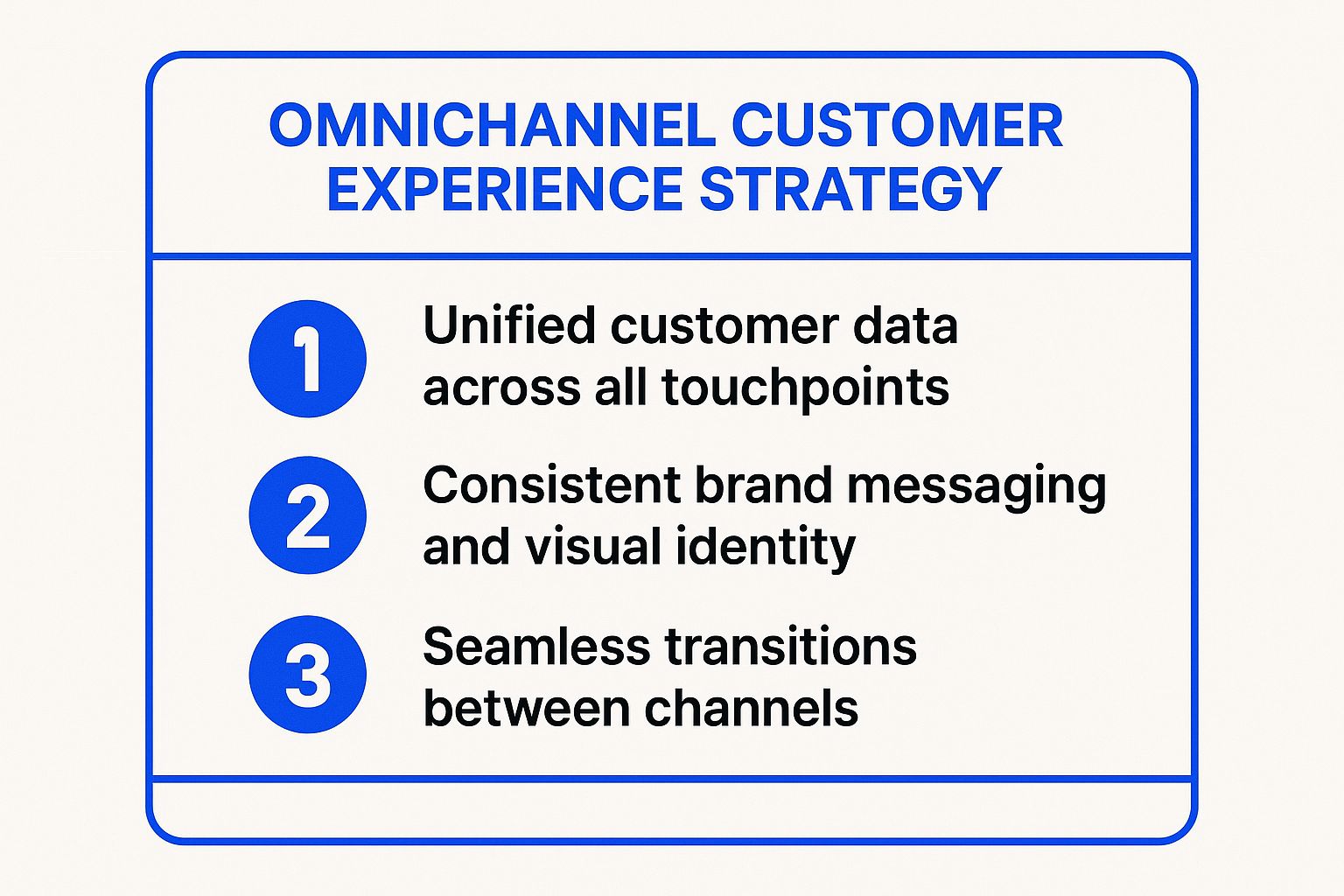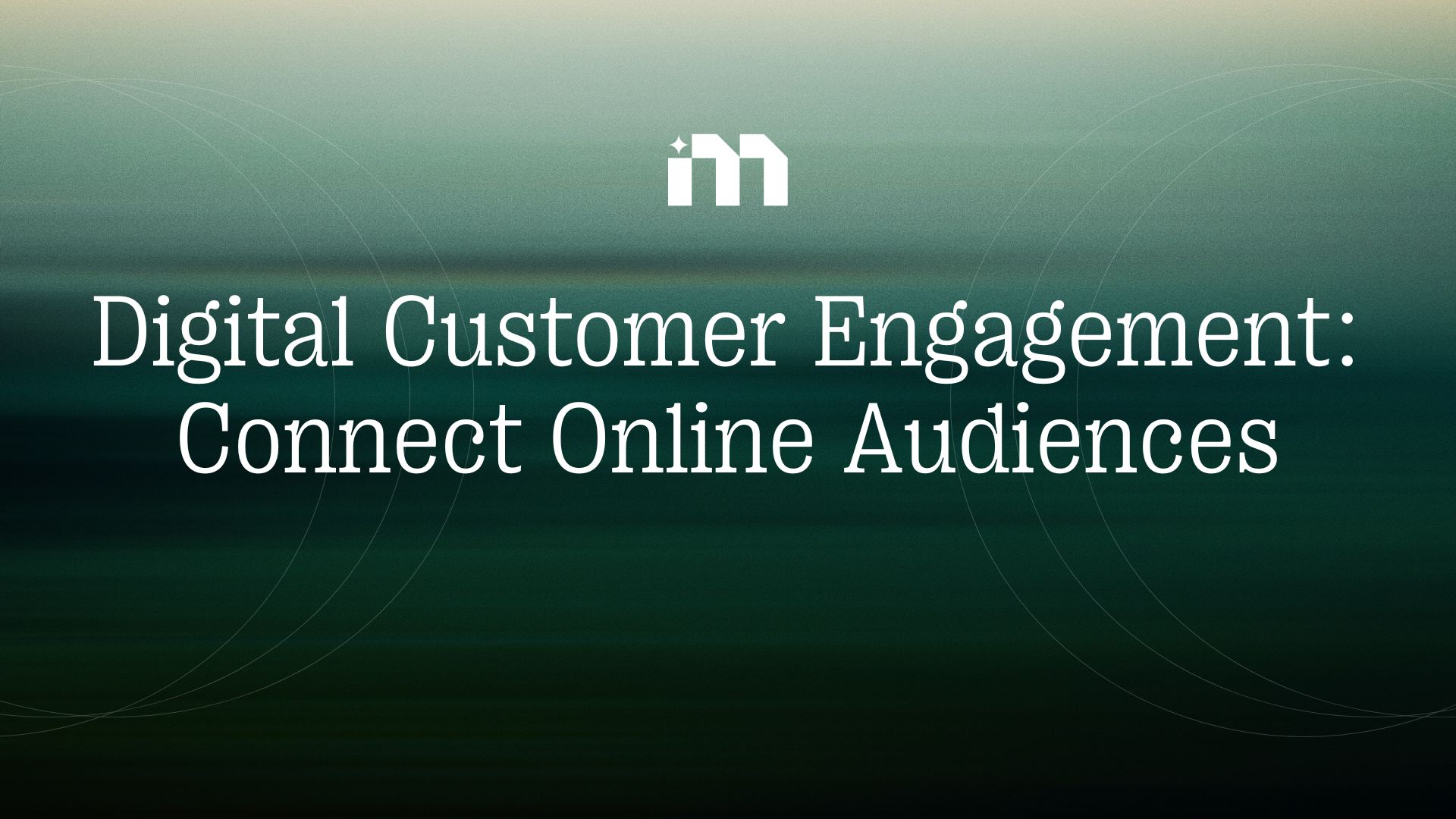Welcome to the future of marketing, where your customer's journey isn't a straight line but a fluid path across multiple devices and platforms. In today's digital world, single-channel campaigns just don't cut it anymore. Customers expect a consistent, personal experience whether they're scrolling social media, opening an email, or browsing your website on a laptop. This is where effective cross channel marketing strategies become essential.
They are no longer a 'nice-to-have'; they are the blueprint for building strong customer relationships and achieving real growth. This article breaks down nine of the most powerful strategies, giving you a clear, simple roadmap.
We will explore how to connect your channels, understand your customer's complete journey, and deliver the right message at the right time. You'll learn how to implement everything from a seamless omnichannel experience to smart retargeting and unified data platforms. Let's get started.
1. Omnichannel Customer Experience Strategy
An omnichannel customer experience puts the customer at the center of everything. Unlike multichannel marketing where each channel works on its own, an omnichannel strategy connects them all to create one seamless journey. The goal is simple: make sure the customer's experience is consistent and unified, whether they're in a physical store, on your mobile app, or seeing a social media ad.
This is one of the most powerful cross channel marketing strategies because it matches how people shop today. Customers switch between devices and expect the experience to follow them. Disney is a great example. Their website, mobile app (My Disney Experience), and in-park MagicBands all work together. You can plan your trip online, manage it on the app, and use the MagicBand for park entry and payments—all part of one smooth experience.
How to Implement an Omnichannel Strategy
To launch this strategy successfully, you need to bring your technology and teams together.
- Map the Customer Journey: Understand every touchpoint a customer has with your brand, from first discovering you to getting support after a purchase.
- Invest in a Unified Data Platform: Use a tool like a Customer Data Platform (CDP) or CRM to create a single view of each customer by combining data from all channels.
- Train Your Staff: Give your customer service teams the tools and information they need to provide consistent help, no matter which channel the customer uses.
- Start Small and Optimize: Begin with smaller integrations, like a "click-and-collect" service, and see how it performs before rolling out bigger changes.
The infographic below shows the key elements that make an omnichannel approach work.

As you can see, a successful omnichannel strategy is built on integrating data, branding, and channel experiences. To learn more about building this framework, check out the foundations of omni-channel marketing.
2. Sequential Messaging Campaigns
Sequential messaging is a smart way to deliver messages to customers in a planned order across different channels. Instead of sending random communications, this strategy tells a story over time, guiding people from awareness to purchase. Each message is triggered by how the user engages, making sure the right content reaches them at the right time.
This is one of the most effective cross channel marketing strategies because it nurtures leads in a structured and automated way. It prevents people from getting disconnected messages and instead creates a logical conversation. For example, Spotify uses this to bring back inactive users. They might start with a "We miss you" email. If that's ignored, they could send a push notification about a new playlist, and finally, an in-app offer for a subscription deal.
How to Implement a Sequential Messaging Campaign
A successful sequence needs careful planning of the customer journey and the triggers for each message.
- Map the Customer Journey: Define the stages you want to guide a customer through. Create a clear plan of messages, channels, and triggers.
- Use Behavioral Triggers: Go beyond just time delays. Trigger messages based on actions like opening an email, clicking a link, or abandoning a cart.
- Test Frequency and Timing: Experiment to find the best times to send messages. A B2B campaign might work best during business hours, while a retail campaign could be better in the evening via SMS. Partnering with a reliable bulk SMS API provider ensures your messages are delivered promptly and at scale, helping maintain engagement across customer journeys.
- Set Clear Exit Rules: Make sure customers stop receiving messages once they make a purchase or complete the desired action. This avoids annoying them with irrelevant content.
3. Cross-Device Retargeting
Cross-device retargeting is a strategy to reconnect with users across all their devices, like smartphones, tablets, and computers. It recognizes that a customer's journey isn't limited to one screen. By identifying the same user on different devices, you can deliver a consistent brand message and keep them engaged as they switch from their phone to their laptop.
This is one of the most effective cross channel marketing strategies because it fits with how people use technology today. Amazon does this well by syncing your shopping cart across its app and website. If you add something to your cart on your phone, it's still there when you log in on your computer. This makes it easy to complete your purchase. Similarly, Netflix's "Continue Watching" feature works seamlessly across all devices, a perfect example of a user-friendly cross-device experience.

How to Implement Cross-Device Retargeting
To do this effectively, you need a reliable way to identify users across their devices.
- Focus on First-Party Data: Encourage users to log in or sign up for newsletters. This gives you a definite way to connect their activity across different platforms.
- Use Probabilistic Matching: For users who aren't logged in, this method uses data points like IP address and browser type to guess that different devices belong to the same person.
- Respect User Privacy: Be transparent about how you use data and offer easy ways for people to opt out. Following privacy rules like GDPR and CCPA is essential for building trust.
- Provide Value: Don't just show the same ad everywhere. Tailor your message to the device. For more details on these tactics, explore the basics of retargeting for e-commerce.
4. Social Commerce Integration
Social commerce integration blends e-commerce features directly into social media platforms. This creates a smooth shopping experience where customers can discover, consider, and buy products without ever leaving their social feed. It shortens the path to purchase and makes buying much easier.
This approach is a standout among cross channel marketing strategies because it lets customers buy at the moment of discovery. Instead of sending them to another website, it allows them to act on their impulse immediately. Brands like Glossier do this by using Instagram's shoppable posts. Followers can tap on a product in a photo and check out right there in the app.

How to Implement a Social Commerce Strategy
To launch this strategy, you need to combine great content with easy-to-use e-commerce tools.
- Choose the Right Platforms: Focus on platforms where your target audience spends their time and that have strong shopping features, like Instagram Shops, Facebook Marketplace, or TikTok Shopping.
- Create Great Visuals: Optimize your product photos and videos for each platform. Use high-quality images and user-generated content (UGC) to show products in a real-world setting.
- Use Social Proof: Encourage and feature customer reviews and ratings in your social shops. This builds trust and helps new customers feel confident about buying.
- Integrate Your Data: Connect your social commerce data with your main CRM. This gives you a complete view of customer interactions and helps with personalized retargeting.
5. Progressive Profiling and Dynamic Content
Progressive profiling is a smart way to build customer profiles over time. Instead of asking for a lot of information at once, this method collects it in small pieces across different interactions. This makes the process less annoying for the customer. The data you collect is then used to power dynamic content, allowing you to deliver more personalized messages on every channel.
This is one of the smartest cross channel marketing strategies because it respects the customer's time while gathering useful insights. Netflix is a master at this. It doesn't ask for your favorite genres upfront; it learns from what you watch. This slowly builds a detailed profile that powers its personalized recommendations, creating a highly relevant experience.
How to Implement Progressive Profiling
To use this strategy, focus on a value exchange—give customers better personalization in return for their information.
- Start with the Basics: In the first interaction, only ask for essential information, like an email address. Later, you can ask for more details like job title or interests.
- Use Implicit Data: Track user behavior on your website, app, and emails. Things like clicks and page views are powerful data points that help build a profile without asking directly.
- Offer Clear Value: Explain how providing more information will lead to a better experience, like personalized content or special offers.
- Ensure Data Governance: Have clear privacy policies and secure data practices to build and maintain customer trust.
6. Attribution Modeling and Customer Journey Analytics
Attribution modeling is a data-driven way to understand which marketing touchpoints lead to conversions. Instead of giving all the credit to the last click, this method analyzes the entire customer journey and assigns value to each interaction, from the first ad they saw to the final email. This gives you a complete picture of your marketing performance across all channels.
This is one of the most critical cross channel marketing strategies because it shows you the true ROI of each channel. It helps you make smarter decisions about where to spend your budget. For example, Google Analytics 4 uses data-driven attribution to assign credit to different touchpoints. This helps brands understand complex sales cycles and optimize their marketing mix.
How to Implement an Attribution Modeling Strategy
To use attribution effectively, you need to combine good analytics with clear business goals.
- Define Conversion Goals: First, decide what a "conversion" means for your business. It could be a sale, a lead form, or a free trial signup.
- Use Multiple Models: Compare different attribution models (like first-touch, last-touch, and data-driven) to get different perspectives on how your channels work together.
- Integrate All Data: Combine data from your CRM, sales systems, and digital analytics for a complete view of the customer journey. Understanding this is key, and resources on B2B Customer Journey Mapping can help.
- Regularly Review and Adjust: Customer behavior changes, so review your models regularly to ensure they're still accurate and adjust your strategy as needed.
For a closer look at the tools that power these insights, you can learn more about analytics for marketing.
7. Content Syndication and Repurposing
Content syndication and repurposing is a strategy to get the most value out of a single piece of content. Instead of creating new content for every platform, you adapt a core piece into different formats and share it across multiple channels. This ensures your main message is delivered in a way that fits each platform's audience.
This is one of the most efficient cross channel marketing strategies because it amplifies your message without a lot more effort. It helps build brand authority and reach different audiences where they are. For example, a detailed report can be turned into a blog post, an infographic for Pinterest, short video clips for TikTok, and a slide deck for LinkedIn. Gary Vaynerchuk’s content model is a perfect example of this.
How to Implement a Content Syndication Strategy
To do this well, you need a systematic approach to creating and distributing content.
- Create Pillar Content: Start with a major piece of content, like an in-depth guide or webinar. This will be the foundation for all other repurposed assets.
- Adapt for Each Platform: Create guidelines for how to adapt content for each channel. For example, a blog post might become a visual carousel on Instagram.
- Use Tools to Track Distribution: Use a content management system (CMS) to manage your content calendar and track where and when each piece is published.
- Monitor Performance: Analyze how different formats perform on various platforms. This data will help you refine your efforts and focus on what works best.
8. Behavioral Trigger Campaigns
Behavioral trigger campaigns are automated marketing actions that respond to specific customer behaviors. Instead of sending generic messages on a schedule, this strategy delivers timely and relevant content based on what a customer does in real time. These campaigns create personalized experiences by reacting to customer intent at the right moment.
This is one of the most effective cross channel marketing strategies because it capitalizes on moments of high engagement. A classic example is Amazon's abandoned cart emails. They are triggered when a customer leaves items in their cart and serve as a helpful reminder. Similarly, Netflix uses your viewing history to trigger personalized recommendations for new shows, keeping you engaged.
How to Implement Behavioral Trigger Campaigns
To launch this strategy, you need to identify valuable behaviors and automate personalized responses.
- Identify Key Triggers: Start with high-intent behaviors like cart abandonment, browsing a specific product category, or signing up for a webinar.
- Set Response Delays: Avoid overwhelming customers. Test different delays, like waiting one hour for the first cart abandonment email and 24 hours for a follow-up.
- Segment Your Responses: Tailor the message based on customer data. A first-time visitor might get a different message than a loyal customer.
- Provide Easy Opt-Outs: Make sure every triggered message includes a simple way for users to opt out. This gives them control and maintains trust.
9. Unified Customer Data Platform Strategy
A Unified Customer Data Platform (CDP) strategy is an approach that brings all your customer data from every touchpoint into a single profile. It breaks down the data silos between your marketing, sales, and service teams to create a 360-degree view of each customer. By combining information from website visits, app usage, social media, and in-store purchases, a CDP allows for real-time personalization and consistent experiences across your entire business.
This is one of the most essential cross channel marketing strategies because it provides the "single source of truth" needed for all your other initiatives. For example, platforms like Salesforce Customer 360 help brands track a customer's journey from a social media ad click to a website visit and finally an in-app purchase. This unified view ensures that messaging is always relevant, no matter where the customer interacts with your brand.
How to Implement a Unified CDP Strategy
Successfully launching a CDP requires a focus on data quality and strategic integration.
- Audit Your Data Sources: Start by identifying every customer touchpoint. Map where data is collected and how it's stored.
- Prioritize Data Governance: Set clear rules for data quality, formatting, and privacy from the start. To get a truly unified view, it's critical to follow essential data management best practices.
- Implement in Phases: Roll out your CDP integration step by step. Start by connecting two or three important channels, like your website and email platform, before adding more.
- Ensure Security and Compliance: Build strong security protocols and make sure your data practices comply with regulations like GDPR and CCPA to protect customer privacy.
Cross-Channel Marketing Strategies Comparison
Unifying Your Strategy for Maximum Impact
Succeeding in today's digital world requires more than just being on multiple channels; it demands a truly connected approach. The cross-channel marketing strategies we've covered all share a single, core idea: the customer should be at the center of a seamless, connected brand conversation. Moving away from siloed marketing is no longer a choice—it's what separates brands that simply exist from brands that connect with their audience.
The journey from separate channels to a unified system is a strategic one. It requires a powerful mix of technology, data-driven insights, and creative execution. Whether you're using behavioral triggers for timely messages or progressive profiling for personalized content, the goal is always the same: create a smooth, intuitive, and valuable experience for your audience at every step. Each strategy, from sequential messaging to cross-device retargeting, is a building block in creating this fluid customer journey.
Key Takeaways and Your Next Steps
Mastering cross-channel marketing is a process of testing, learning, and improving. Instead of trying to change everything at once, focus on strategic steps. Here's what you can do to get started:
- Audit Your Current Channels: Begin by mapping your existing customer touchpoints. Find where communication feels disconnected and identify the biggest opportunities for integration.
- Prioritize Data Unification: A single source of truth is the foundation. Start consolidating your customer data to get a 360-degree view that can inform all your cross channel marketing strategies.
- Pilot One or Two Strategies: Choose a strategy that aligns with your most important business goals. If customer retention is a priority, a behavioral trigger campaign is a great place to start. If you want to improve top-of-funnel efficiency, try content syndication.
- Measure, Analyze, and Adapt: Use robust tracking and attribution to see what's working. Use the insights from your pilot programs to understand your audience better and continuously adapt your approach based on real-world data.
By adopting these powerful cross-channel marketing strategies, you are building a resilient, customer-focused marketing engine. You are creating a system where each interaction on one channel improves the next, fostering deeper engagement, building strong brand loyalty, and driving sustainable growth. The future of marketing isn't about shouting louder; it's about speaking with a single, clear voice across every platform.
Ready to break down your marketing silos and unify your advertising efforts? Start creating truly integrated and effective cross channel marketing strategies today by exploring what Markopolo can do for your business.








.jpg)
.png)



